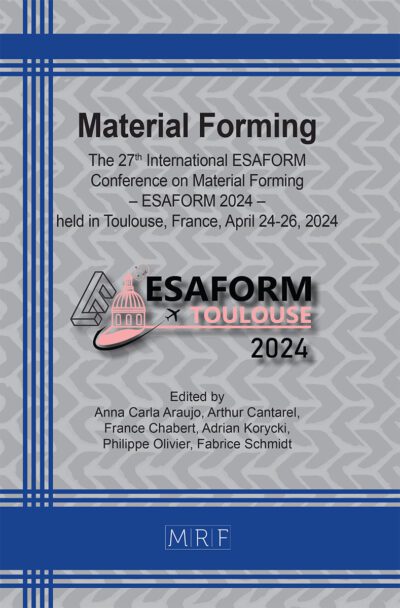Finite element modeling (FEM) as a design tool to produce thin wall structures in laser powder bed fusion (L-PBF)
POLLARA Gaetano, PALMERI Dina, BUFFA Gianluca, FRATINI Livan
download PDFAbstract. Laser Powder Bed Fusion (LPBF) has been widely adopted in many industrial sectors such as biomedical, automotive, and aerospace thanks to the possibility to produce objects with complex shapes and meet customers’ needs. Despite all the advantages that LPBF can offer, the rise of residual stress due to the high thermal gradients generated during the process can limit its application. This is the case with thin-wall structures where the build-up of residual stress can compromise the success of the printing process. Being able to print this structure can be useful in fuel cell applications where the implementation of cooling channels in bipolar plates can improve their performance. This paper aims to provide guidelines for designing thin-wall structures produced by LPBF processes through numerical simulations by understanding the effect of residual stress on part distortion.
Keywords
Numerical Simulation, Laser Powder Bed Fusion, Ti-6Al-4V
Published online 4/24/2024, 7 pages
Copyright © 2024 by the author(s)
Published under license by Materials Research Forum LLC., Millersville PA, USA
Citation: POLLARA Gaetano, PALMERI Dina, BUFFA Gianluca, FRATINI Livan, Finite element modeling (FEM) as a design tool to produce thin wall structures in laser powder bed fusion (L-PBF), Materials Research Proceedings, Vol. 41, pp 264-270, 2024
DOI: https://doi.org/10.21741/9781644903131-30
The article was published as article 30 of the book Material Forming
![]() Content from this work may be used under the terms of the Creative Commons Attribution 3.0 license. Any further distribution of this work must maintain attribution to the author(s) and the title of the work, journal citation and DOI.
Content from this work may be used under the terms of the Creative Commons Attribution 3.0 license. Any further distribution of this work must maintain attribution to the author(s) and the title of the work, journal citation and DOI.
References
[1] M.K. Singla, P. Nijhawan, A.S. Oberoi, Hydrogen fuel and fuel cell technology for cleaner future: a review, Environmental Science and Pollution Research 28 (2021) 15607–15626. https://doi.org/10.1007/s11356-020-12231-8
[2] S. Karimi, N. Fraser, B. Roberts, F.R. Foulkes, A review of metallic bipolar plates for proton exchange membrane fuel cells: Materials and fabrication methods, Advances in Materials Science and Engineering 2012 (2012). https://doi.org/10.1155/2012/828070
[3] B.G. Pollet, S.S. Kocha, I. Staffell, Current status of automotive fuel cells for sustainable transport, Curr Opin Electrochem 16 (2019) 90–95. https://doi.org/10.1016/j.coelec.2019.04.021
[4] S. Celik, B. Timurkutluk, U. Aydin, M. Yagiz, Development of titanium bipolar plates fabricated by additive manufacturing for PEM fuel cells in electric vehicles, Int J Hydrogen Energy 47 (2022) 37956–37966. https://doi.org/10.1016/j.ijhydene.2022.08.282
[5] T. DebRoy, H.L. Wei, J.S. Zuback, T. Mukherjee, J.W. Elmer, J.O. Milewski, A.M. Beese, A. Wilson-Heid, A. De, W. Zhang, Additive manufacturing of metallic components – Process, structure and properties, Prog Mater Sci 92 (2018) 112–224. https://doi.org/10.1016/j.pmatsci.2017.10.001
[6] S.H. Wang, J. Peng, W.B. Lui, J.S. Zhang, Performance of the gold-plated titanium bipolar plates for the light weight PEM fuel cells, J Power Sources 162 (2006) 486–491. https://doi.org/10.1016/j.jpowsour.2006.06.084
[7] G. Buffa, D. Palmeri, G. Pollara, F. Di Franco, M. Santamaria, L. Fratini, Process parameters and surface treatment effects on the mechanical and corrosion resistance properties of Ti6Al4V components produced by laser powder bed fusion, Progress in Additive Manufacturing (2023). https://doi.org/10.1007/s40964-023-00440-9
[8] C. Chen, Z. Xiao, H. Zhu, X. Zeng, Deformation and control method of thin-walled part during laser powder bed fusion of Ti–6Al–4V alloy, The International Journal of Advanced Manufacturing Technology 110 (2020) 3467–3478. https://doi.org/10.1007/s00170-020-06104-0
[9] G. Buffa, A. Costa, D. Palmeri, G. Pollara, A. Barcellona, L. Fratini, A new control parameter to predict micro-warping-induced job failure in LPBF of TI6AL4V titanium alloy, International Journal of Advanced Manufacturing Technology 126 (2023). https://doi.org/10.1007/s00170-023-11179-6
[10] T. Lee, U. Auyeskhan, N.-H. Kim, D.-H. Kim, Residual Stress and Dimensional Deviation in a Commercially Pure Titanium Thin Bipolar Plate for a Fuel Cell Using Laser Power Bed Fusion, Metals (Basel) 13 (2023) 1840. https://doi.org/10.3390/met13111840
[11] D. Palmeri, G. Pollara, R. Licari, F. Micari, Finite Element Method in L-PBF of Ti-6Al-4V: Influence of Laser Power and Scan Speed on Residual Stress and Part Distortion, Metals (Basel) 13 (2023) 1907. https://doi.org/10.3390/met13111907













